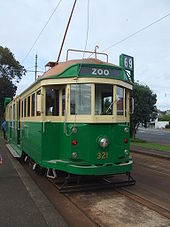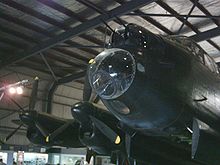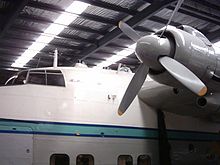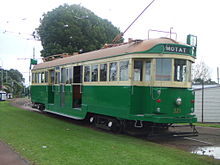- Museum of Transport and Technology
-
 A MOTAT to Zoo tram, Auckland, 2006. The tram is a W2 class Melbourne tram, number 321.
A MOTAT to Zoo tram, Auckland, 2006. The tram is a W2 class Melbourne tram, number 321.
The Museum of Transport and Technology (MOTAT) is a museum located in Western Springs, Auckland, New Zealand. It is located close to the Western Springs Stadium, Auckland Zoo and the Western Springs Park. The museum has large collections of civilian and military aircraft and other land transport vehicles. An ongoing programme is in place to restore and conserve items in the collections. This work is largely managed by volunteers many of whom have been associated with MOTAT for upwards of four decades. Since the passing of the Museum of Transport and Technology Act in 2000, new management and the support of full-time professional museum staff and a large number of dedicated long term volunteers have ensured the Museum's future.[1] New public programmes and facilities now promote the collections.
MOTAT was established in 1960 by a combination of groups including the Old Time Transport Preservation League, which was formed in 1957 and preserved trams and railway locomotives. MOTAT was formally opened in 1964.
Contents
MOTAT 1 - Great North Road
MOTAT 1 was built around the site of a beam engine pump house, which originally provided Auckland's water supply (system similar to the Crofton Pumping Station and Markfield Beam Engine). The Council engaged the services of famed engineer, William Errington, to design and construct the Pumphouse and Boiler house to provide the first pressurised water supply to Auckland. Adjacent swampland was excavated creating a 6-foot-deep (1.8 m) dammed lake, which is filled by three natural springs. This area is now the Western Springs Lake and parkland. The engine is a Double Woolf Compound built by John Key and Sons, Kirkcaldy in Scotland, who also built the long scrapped Lancashire boilers that originally provided the steam. The Western Springs Water Works officially opened in a small ceremony on 10 July 1877. The pumphouse was superseded by Auckland’s extensive dam system and reticulation in 1928. Restoration and earthquake strengthening of the building was completed in 2002 and overhaul of the long dormant Beam Engine commenced at the start of 2005. On 11 October 2007 the engine moved under pneumatic pressure for the first time in 79 years and was finally tested under steam during the evening of 29 November the same year. The Beam engine was re-commissioned in a special public opening on 19 April 2008. A range of other early steam engines are kept in running order including a 1910 Tangye steam engine, an impressive 1911 triple expansion engine built by Campbell Calderwood, Paisley in Scotland which was formerly from the ill fated Sydney Ferry The Greycliffe which sank on 3 November 1927 after being hit by the much larger Union Steam Ship Company’s Royal Mail Steamship Tahiti with the loss of 40 lives. The engine ended its commercial life in the Tirau dairy factory. Steam for the Beam Engine and other artefacts provided by a 1957 Daniel Adamson steam boiler, which was formerly used at Frankham’s Mill, Te Puna. The steam artefacts can be seen running on many week days and live weekends.
Exhibits include trains, trams, vintage traction engines, carriages, cars, buses, trolleybuses and trucks, particularly fire engines, electrical equipment, space flight exhibits including a Corporal rocket and general science exhibits. There is also a 'colonial village' of early shops and houses, including a fencible cottage and a blacksmith shop.
In the 1970s visitors to MOTAT were entertained by the MOTAT Chorus, a group of barbershop singers who later became the Auckland City Of Sails Chorus.
The 'Pioneers of Aviation' Pavilion holds memorabilia of early aviators. The displays include miscellaneous parts from Richard Pearse's experimental aircraft, (together with research supporting the claim that he made uncontrolled hops/flights prior to the Wright brothers), a replica of the craft which was flown and his third aircraft (an attempt at a VTOL tilt rotor craft). The pavilion also holds relics from the Walsh Brothers' flights and school, and a library and archive of transport resources named in memory of the Walsh Brothers available to all MOTAT visitors and via the MOTAT website for virtual visitors. Also celebrated is Charles Kingsford-Smith's trans-Tasman flight in the Southern Cross, Jean Batten's England — New Zealand flight and later record breaking efforts (her Percival Gull is exhibited at Auckland Airport). The larger civil aviation exhibits continue over at MOTAT 2 with displays relating to the Pan American Airways and Imperial Airways flying boats of the late 1930s and TEAL flying boats of the 40s and 50s.
The Road transport collection rotationally displays in excess of 100 cars, trucks, motorbikes and emergency vehicles. Some of the iconic vehicles in the collection include one of the first Trekka utility vehicles, New Zealand's only homegrown production vehicle built between 1966 and 1973, based on Czechoslovakian Skoda engines and chassis. Other vehicles include a 1960s Cooper Climax race car, an early American Brush Motor Car Company runabout, an International horseless carriage, an Austin Motor Company beer tanker (the first in New Zealand) and a wide number of other vehicles. Also in the collection is one of the Massey Ferguson tractors which Edmund Hillary used to lay supply depots for the Commonwealth Trans-Antarctic Expedition, and with which he beat British explorer Dr Vivian Fuchs Sno-Cats to the South Pole on 3 January 1958.
MOTAT also houses the New Zealand Police vehicle collection spanning much of the 20th century. This includes patrol cars, Bedford mobile incident truck and the former New Zealand Transport Department, later New Zealand Ministry of Transport or M.O.T. patrol cars and patrol motorbikes, the road policing duties of which were combined into the New Zealand Police force in the early 1990s.
Trams are displayed at MOTAT 1 and operate daily between MOTAT 1's Great North Road Site, via Western Springs Park and Auckland Zoo to MOTAT 2. The extended line was opened by Helen Clark on Friday 27 April 2007.[2]
MOTAT 2 - Motions Rd / Meola Road
 An Avro Lancaster bomber at MOTAT 2.
An Avro Lancaster bomber at MOTAT 2.
 A Short Solent flying boat at MOTAT 2.
A Short Solent flying boat at MOTAT 2.
MOTAT 2's NZ$15 million extended aviation pavilion housing the "Sir Keith Park Memorial Aviation Collection" opened Friday 9 September. Catch the Outer Link bus service from Wellesley Street West outside the Civic Theatre in Downtown Auckland to the MOTAT 2 bus stop in Meola Road.
Also known in the past as the 'Sir Keith Park Memorial Airfield', named after Keith Park, the Battle of Britain and Battle of Malta hero, MOTAT's aviation collection is on a separate site, neighbouring the Waitemata harbour and Auckland Zoo. It contains memorials to Fleet Air Arm and RAF Bomber Command pilots, radar and other aviation related material, as well as workshops for work on other vehicles, but the main feature is the collection of New Zealand's civil and some Royal New Zealand Air Force aircraft.
There is also a military section which restores and demonstrates a selection of Second World War military trucks, light tracked vehicles and tanks of Allied forces. The military section has regular open days when the Military Reenactment Society displays and demonstrates the vehicles and uniforms.[3]
MOTAT 2 also has an operational railway with 1 km of track, stations and a selection of former New Zealand Government Railways, light industrial locomotives, wagons and carriages.
MOTAT 2 has undergone a major expansion project to increase its covered display space. This involved moving and restoring the existing Blister hangar and constructing a new and larger building to extend the main display hangar. Reopened 9 September 2011 at an estimated cost of NZ$16.6M.[4] Highlights include the De Havalland Mosquito and Hudson finally being restored, assembled and on display. The Teal Solent, RNZAF Sunderland, Top Dressing Ventura and NAC DC3 Dakota will be moved inside as their overhauls and external painting is completed towards the end of summer 2012.
Collections
Main article: MOTAT collectionsMOTAT features several major collections of transport vehicles:
- Aircraft collection — houses New Zealand's largest collection of civil and military aircraft, all with genuine New Zealand aviation pedigrees. These range from relics from Richard Pearse's first 1903 aircraft and an interpretive replica, as well as a large part of his original third vertical takeoff aircraft. 1930's Fox and Tiger Moths, 1930's Rapide, Short Solent 1940s double decked flying boat, from New Zealand's first International Airline TEAL, a Short Sunderland marine patrol flying boat, De Havilland Mosquito wooden fighter bomber, a restored 1940s Avro Lancaster bomber, Douglas DC-3 Dakota through to a De Havilland Vampire 1950s jet fighter and an RNZN Westland Wasp maritime helicopter and most recently a former RNZAF Douglas A-4 Skyhawk. The aviation site of MOTAT located in Meola Road is also known as the Keith Park Memorial Airfield. A replica Hawker Hurricane is on a plinth in the markings of New Zealander and RAF Air Chief Marshal Keith Park memorial at the entrance.
- Railway locomotives and collection — includes seven steam locomotives from a pioneering 1874 NZR F class to the iconic NZR K class steam locomotive, smaller branch line, industrial and logging tank locomotives. Also six diesel, petrol and petrol electric locomotives, including the NZR DA class which was built to replace the mighty K class from the 1950s through the 1970s and became the most prolific mainline locomotive in New Zealand.
- Railway carriages — the collection also includes stations, carriages, wagons and other rolling stock.
- Tram collection — the collection includes over 20 electric, steam and cable trams, many of which are operational, with support equipment and vehicles from former New Zealand tramway systems of Auckland, Wellington, Wanganui and the Mornington Cable tram system in Dunedin. Auckland's horse drawn tramway opened in 1884 and was replaced by the electric tram system in 1902, closing in 1956. The final closure of an original street tramway was in Wellington in 1964. An 1883 Dunedin Cable Car trailer is the sole South Island tramway exhibit and there are additional trams from Melbourne and Sydney, Australia. The museum is one of five operational Museum and Heritage Tramways in New Zealand.
- Petrol / diesel bus collection — contains a significant collection of historic buses from the Auckland region, including a 1924 White Motor Company 4 cylinder side valve petrol engine, wooden bodied 23 seat omnibus, through a 1954 Bedford SB, petrol engine, 35 seat lightweight wooden body-bus specifically built for Grafton Bridge services, through to a 1978 Mercedes-Benz O305 which last operated in 2005.
- Trolleybus collection — this collection contains a representative cross-section of trolleybuses which operated in Auckland between 1938 and 1980. First used on a 1 km department store-operated route in central Auckland from 1938, the trolleybus system later duplicated and then replaced the aging tram system between 1949 and 1956. The trolleybuses were in turn replaced by diesel buses in 1980.
Tram service
Tramlines on sleepered track set under bitumen were laid within the museum boundaries with trams commencing operation on 16 December 1967. The Museum tramline was later extended beyond the Museum grounds along Gt North Road and opened on 19 December 1980. A further extension along Motions Road to Auckland Zoo commenced services on 5 December 1981 using rail set in mass concrete. In 2006-07 the tram line was further extended by a distance of 636 metres, to the aviation hangar at MOTAT 2, the service commencing on 27 April 2007. The tramway is dual gauge, employing 4 foot and 4 foot 8½ inches gauges, the rail welded and set in mass concrete.
Trams are operated daily between MOTAT, alongside the Western Springs Park and precinct, past Auckland Zoo to MOTAT 2 and connect both Museum sites. The Museum admission includes the tram ride and casual tram passengers may purchase cash fares on board the trams. Tram service between the two parts of Motat operates 7 days a week during opening hours, with trams leaving every 30 minutes.[3]
See also
References
- ^ Museum of Transport and Technology Act 2000
- ^ Western Springs Tramway Extension. MOTAT. Retrieved 8 August 2010.
- ^ a b Official Museum Website
- ^ [1]
External links
- MOTAT — Museum of Transport and Technology (official website)
Coordinates: 36°52′02″S 174°43′39″E / 36.867313°S 174.727635°E
Categories:- Museums in Auckland
- Aerospace museums in New Zealand
- Railway museums in New Zealand
- Automobile museums in New Zealand
- Technology museums
- Science museums in New Zealand
- Heritage streetcar systems
- Heritage railways in New Zealand
Wikimedia Foundation. 2010.

